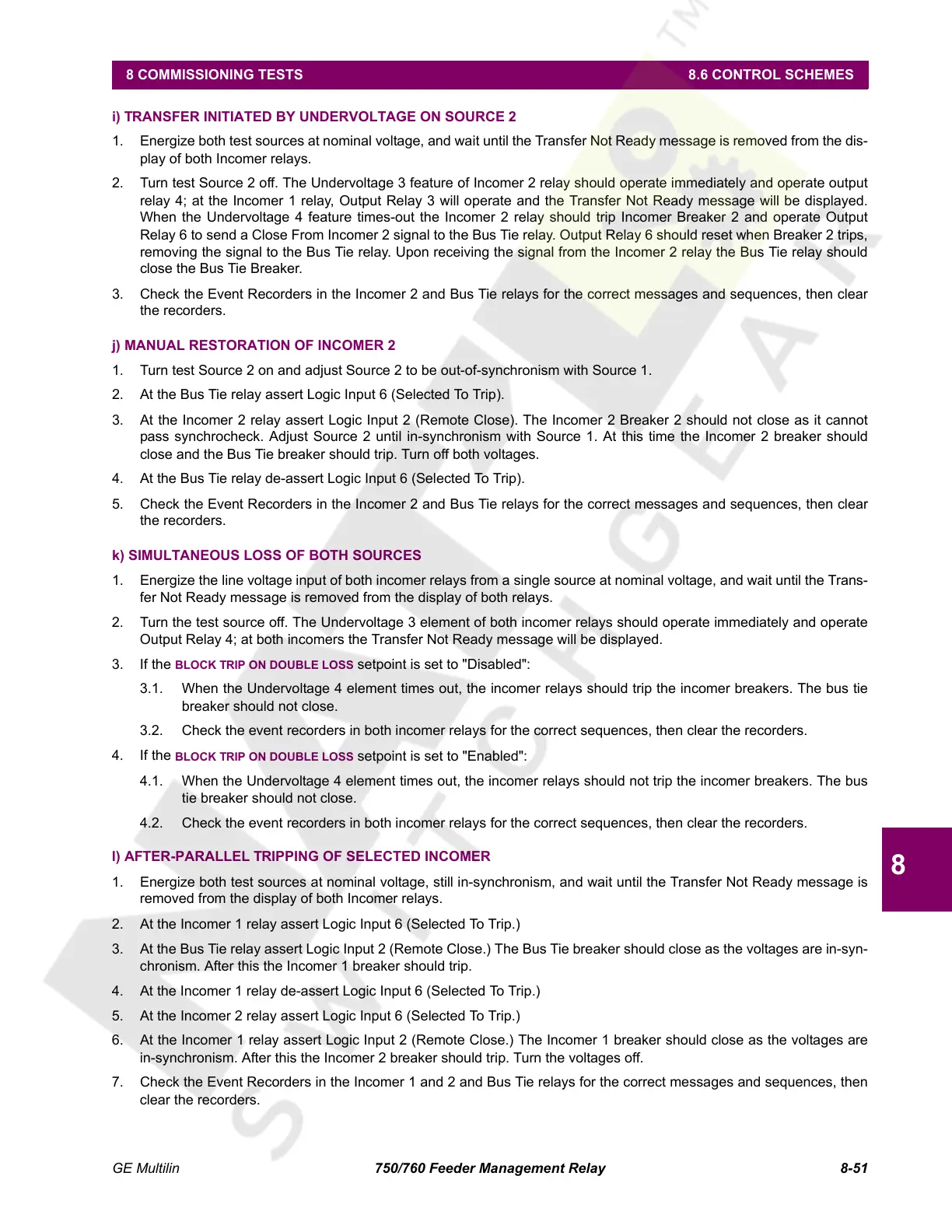GE Multilin 750/760 Feeder Management Relay 8-51
8 COMMISSIONING TESTS 8.6 CONTROL SCHEMES
8
i) TRANSFER INITIATED BY UNDERVOLTAGE ON SOURCE 2
1. Energize both test sources at nominal voltage, and wait until the Transfer Not Ready message is removed from the dis-
play of both Incomer relays.
2. Turn test Source 2 off. The Undervoltage 3 feature of Incomer 2 relay should operate immediately and operate output
relay 4; at the Incomer 1 relay, Output Relay 3 will operate and the Transfer Not Ready message will be displayed.
When the Undervoltage 4 feature times-out the Incomer 2 relay should trip Incomer Breaker 2 and operate Output
Relay 6 to send a Close From Incomer 2 signal to the Bus Tie relay. Output Relay 6 should reset when Breaker 2 trips,
removing the signal to the Bus Tie relay. Upon receiving the signal from the Incomer 2 relay the Bus Tie relay should
close the Bus Tie Breaker.
3. Check the Event Recorders in the Incomer 2 and Bus Tie relays for the correct messages and sequences, then clear
the recorders.
j) MANUAL RESTORATION OF INCOMER 2
1. Turn test Source 2 on and adjust Source 2 to be out-of-synchronism with Source 1.
2. At the Bus Tie relay assert Logic Input 6 (Selected To Trip).
3. At the Incomer 2 relay assert Logic Input 2 (Remote Close). The Incomer 2 Breaker 2 should not close as it cannot
pass synchrocheck. Adjust Source 2 until in-synchronism with Source 1. At this time the Incomer 2 breaker should
close and the Bus Tie breaker should trip. Turn off both voltages.
4. At the Bus Tie relay de-assert Logic Input 6 (Selected To Trip).
5. Check the Event Recorders in the Incomer 2 and Bus Tie relays for the correct messages and sequences, then clear
the recorders.
k) SIMULTANEOUS LOSS OF BOTH SOURCES
1. Energize the line voltage input of both incomer relays from a single source at nominal voltage, and wait until the Trans-
fer Not Ready message is removed from the display of both relays.
2. Turn the test source off. The Undervoltage 3 element of both incomer relays should operate immediately and operate
Output Relay 4; at both incomers the Transfer Not Ready message will be displayed.
3. If the
BLOCK TRIP ON DOUBLE LOSS setpoint is set to "Disabled":
3.1. When the Undervoltage 4 element times out, the incomer relays should trip the incomer breakers. The bus tie
breaker should not close.
3.2. Check the event recorders in both incomer relays for the correct sequences, then clear the recorders.
4. If the
BLOCK TRIP ON DOUBLE LOSS setpoint is set to "Enabled":
4.1. When the Undervoltage 4 element times out, the incomer relays should not trip the incomer breakers. The bus
tie breaker should not close.
4.2. Check the event recorders in both incomer relays for the correct sequences, then clear the recorders.
l) AFTER-PARALLEL TRIPPING OF SELECTED INCOMER
1. Energize both test sources at nominal voltage, still in-synchronism, and wait until the Transfer Not Ready message is
removed from the display of both Incomer relays.
2. At the Incomer 1 relay assert Logic Input 6 (Selected To Trip.)
3. At the Bus Tie relay assert Logic Input 2 (Remote Close.) The Bus Tie breaker should close as the voltages are in-syn-
chronism. After this the Incomer 1 breaker should trip.
4. At the Incomer 1 relay de-assert Logic Input 6 (Selected To Trip.)
5. At the Incomer 2 relay assert Logic Input 6 (Selected To Trip.)
6. At the Incomer 1 relay assert Logic Input 2 (Remote Close.) The Incomer 1 breaker should close as the voltages are
in-synchronism. After this the Incomer 2 breaker should trip. Turn the voltages off.
7. Check the Event Recorders in the Incomer 1 and 2 and Bus Tie relays for the correct messages and sequences, then
clear the recorders.
Courtesy of NationalSwitchgear.com

